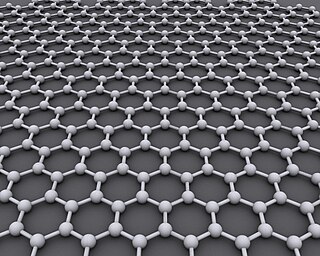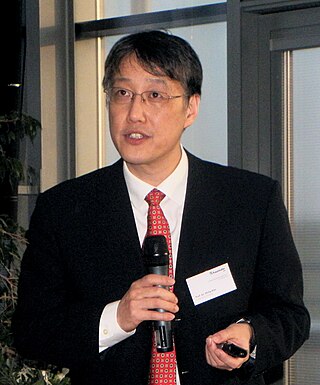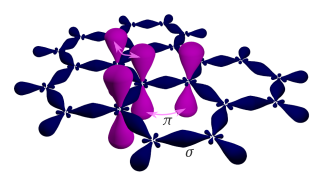Related Research Articles

Graphene is an allotrope of carbon consisting of a single layer of atoms arranged in a hexagonal lattice nanostructure. The name is derived from "graphite" and the suffix -ene, reflecting the fact that the graphite allotrope of carbon contains numerous double bonds.

In condensed matter physics, Hofstadter's butterfly is a graph of the spectral properties of non-interacting two-dimensional electrons in a perpendicular magnetic field in a lattice. The fractal, self-similar nature of the spectrum was discovered in the 1976 Ph.D. work of Douglas Hofstadter and is one of the early examples of modern scientific data visualization. The name reflects the fact that, as Hofstadter wrote, "the large gaps [in the graph] form a very striking pattern somewhat resembling a butterfly."

The Schwinger effect is a predicted physical phenomenon whereby matter is created by a strong electric field. It is also referred to as the Sauter–Schwinger effect, Schwinger mechanism, or Schwinger pair production. It is a prediction of quantum electrodynamics (QED) in which electron–positron pairs are spontaneously created in the presence of an electric field, thereby causing the decay of the electric field. The effect was originally proposed by Fritz Sauter in 1931 and further important work was carried out by Werner Heisenberg and Hans Heinrich Euler in 1936, though it was not until 1951 that Julian Schwinger gave a complete theoretical description.

Sir Andre Konstantin Geim is a Russian-born Dutch–British physicist working in England in the School of Physics and Astronomy at the University of Manchester.
Pomeranchuk cooling is the phenomenon in which liquid helium-3 will cool if it is compressed isentropically when it is below 0.3 K. This occurs because helium-3 has the unusual property that its solid state can have a higher entropy than its liquid state. The effect was first observed by Yuri Anufriev in 1965. This can be used to construct a cryogenic cooler.

Philip Kim is a South Korean physicist. He is a condensed matter physicist known for study of quantum transport in carbon nanotubes and graphene, including observations of quantum Hall effects in graphene.
Bilayer graphene is a material consisting of two layers of graphene. One of the first reports of bilayer graphene was in the seminal 2004 Science paper by Geim and colleagues, in which they described devices "which contained just one, two, or three atomic layers"
Allan H. MacDonald is a theoretical condensed matter physicist and the Sid W. Richardson Foundation Regents Chair Professor of Physics at The University of Texas at Austin. He was born in Antigonish, Nova Scotia, Canada, and attended local schools completing a B.S. at St. Francis Xavier University in 1973. He completed his Ph.D.in physics at The University of Toronto in 1978, working with S.H. Vosko on relativistic generalizations of density functional theory, and on the application of density functional theory to magnetism in metals.
Bernhard Keimer is a German physicist and Director at the Max Planck Institute for Solid State Research. His research group uses spectroscopic methods to explore quantum many-body phenomena in correlated-electron materials and metal-oxide heterostructures.

In physics, Dirac cones are features that occur in some electronic band structures that describe unusual electron transport properties of materials like graphene and topological insulators. In these materials, at energies near the Fermi level, the valence band and conduction band take the shape of the upper and lower halves of a conical surface, meeting at what are called Dirac points.

Jason Joseph William Alexander Robinson is a British academic, and Professor of Materials Physics at the University of Cambridge in the Department of Materials Science & Metallurgy. He is also a Fellow of St John's College, Cambridge. He has worked extensively in the areas of superconductivity, superconducting spintronics, spintronics, magnetism, quantum materials, and nanoelectronics. Particular research topics include the superconductor proximity effect, unconventional superconductivity, quantum and topological transport.

Graphene is a semimetal whose conduction and valence bands meet at the Dirac points, which are six locations in momentum space, the vertices of its hexagonal Brillouin zone, divided into two non-equivalent sets of three points. The two sets are labeled K and K'. The sets give graphene a valley degeneracy of gv = 2. By contrast, for traditional semiconductors the primary point of interest is generally Γ, where momentum is zero. Four electronic properties separate it from other condensed matter systems.
The term Dirac matter refers to a class of condensed matter systems which can be effectively described by the Dirac equation. Even though the Dirac equation itself was formulated for fermions, the quasi-particles present within Dirac matter can be of any statistics. As a consequence, Dirac matter can be distinguished in fermionic, bosonic or anyonic Dirac matter. Prominent examples of Dirac matter are graphene and other Dirac semimetals, topological insulators, Weyl semimetals, various high-temperature superconductors with -wave pairing and liquid helium-3. The effective theory of such systems is classified by a specific choice of the Dirac mass, the Dirac velocity, the gamma matrices and the space-time curvature. The universal treatment of the class of Dirac matter in terms of an effective theory leads to a common features with respect to the density of states, the heat capacity and impurity scattering.

Twistronics is the study of how the angle between layers of two-dimensional materials can change their electrical properties. Materials such as bilayer graphene have been shown to have vastly different electronic behavior, ranging from non-conductive to superconductive, that depends sensitively on the angle between the layers. The term was first introduced by the research group of Efthimios Kaxiras at Harvard University in their theoretical treatment of graphene superlattices.
Pablo Jarillo-Herrero is a Spanish physicist and current Cecil and Ida Green Professor of Physics at Massachusetts Institute of Technology (MIT).
Tony Frederick Heinz is an American physicist.
Rafi Bistritzer is an Israeli physicist, and manager of an algorithms group at Applied Materials. He is the winner of the 2020 Wolf Prize in Physics, together with Pablo Jarillo-Herrero and Alan MacDonald, for “pioneering theoretical and experimental work on twisted bilayer graphene.”
Karin M. Rabe is an American condensed matter and computational materials physicist known for her studies of materials near phase transitions, including ferroelectrics, multiferroics, and martensites. She also works on the theoretical design of new materials. She is a distinguished professor and Board of Governors Professor of Physics at Rutgers University.
The term heterostrain was proposed in 2018 in the context of materials science to simplify the designation of possible strain situations in van der Waals heterostructures where two two-dimensional materials are stacked on top of each other. These layers can experience the same deformation (homostrain) or different deformations (heterostrain). In addition to twist, heterostrain can have important consequences on the electronic and optical properties of the resulting structure. As such, the control of heterostrain is emerging as a sub-field of straintronics in which the properties of 2D materials are controlled by strain. Recent works have reported a deterministic control of heterostrain by sample processing or with the tip of an AFM of particular interest in twisted heterostructures. Heterostrain alone has also been identified as a parameter to tune the electronic properties of van der Waals structures as for example in twisted graphene layers with biaxial heterostrain.
A Josephson diode is an electronic device that superconducts electrical current in one direction and is resistive in the other direction. The device is a Josephson junction exhibiting a superconducting diode effect (SDE). It is an example of a quantum material Josephson junction (QMJJ), where the weak link in the junction is a quantum material. The Josephson diode effect can occur in superconducting devices where time reversal symmetry and inversion symmetry are broken.
References
- ↑ "Andrei, Eva Y." Rutgers University.
- ↑ "Oral-History:Eva Andrei - Engineering and Technology History Wiki". 2020-01-03. Archived from the original on 2020-01-03. Retrieved 2021-11-02.
- ↑ "The Andrei Research Group". Rutgers University.
- ↑ "Eva Y. Andrei". www.nasonline.org. Retrieved 2024-01-12.
- ↑ "The Andrei Research Group". Rutgers University.
- ↑ "Eva Y. Andrei American Academy of Arts and Sciences". American Academy of Arts and Sciences.
- ↑ Andrei, EY; Deville, G; Glattli, DC; Williams, FIB; Paris, E; Etienne, B (1988). "Observation of a Magnetically Induced Wigner Solid". Physical Review Letters. 60 (26): 2765–2768. Bibcode:1988PhRvL..60.2765A. doi:10.1103/PhysRevLett.60.2765. PMID 10038446.
- ↑ Du, X; Skachko, I; Barker, A; Andrei, EY (2008). "Approaching ballistic transport in suspended graphene". Nature Biotechnology. 3 (8): 491–495. arXiv: 0802.2933 . Bibcode:2008NatNa...3..491D. doi:10.1038/nnano.2008.199. PMID 18685637. S2CID 118441080.
- ↑ Li, Guohong; Luican, A.; Lopes dos Santos, J. M. B.; Castro Neto, A. H.; Reina, A.; Kong, J.; Andrei, E. Y. (2010). "Observation of Van Hove singularities in twisted graphene layers". Nature Physics. 6 (2): 109–113. arXiv: 0912.2102 . Bibcode:2010NatPh...6..109L. doi:10.1038/nphys1463. ISSN 1745-2481. S2CID 8626222.
- ↑ "Eva Y. Andrei American Academy of Arts and Sciences". American Academy of Arts and Sciences.
- ↑ Du, X; Skachko, I; Duerr, F; Luican, A; Andrei, EY (2009). "Fractional quantum Hall effect and insulating phase of Dirac electrons in graphene". Nature. 462 (7270): 192–195. arXiv: 0910.2532 . Bibcode:2009Natur.462..192D. doi:10.1038/nature08522. PMID 19829294. S2CID 2927627.
- ↑ The News Staff (2009-12-18). "The Runners-Up". Science. 326 (5960): 1600–1607. Bibcode:2009Sci...326.1600.. doi:10.1126/science.326.5960.1600. PMID 20019253.
- ↑ Jiang, Yuhang; Lai, Xinyuan; Watanabe, Kenji; Taniguchi, Takashi; Haule, Kristjan; Mao, Jinhai; Andrei, Eva Y. (2019). "Charge order and broken rotational symmetry in magic-angle twisted bilayer graphene". Nature. 573 (7772): 91–95. arXiv: 1904.10153 . Bibcode:2019Natur.573...91J. doi:10.1038/s41586-019-1460-4. ISSN 0028-0836. PMID 31365921. S2CID 198147548.
- ↑ Hays, Brooks (August 1, 2019). "Graphene discovery could make room-temperature superconductors possible". UPI. Retrieved 2021-11-02.
- ↑ Duan, Junxi; Wang, Xiaoming; Lai, Xinyuan; Li, Guohong; Watanabe, Kenji; Taniguchi, Takashi; Zebarjadi, Mona; Andrei, Eva Y. (2016-12-13). "High thermoelectricpower factor in graphene/hBN devices". Proceedings of the National Academy of Sciences. 113 (50): 14272–14276. arXiv: 1607.00583 . Bibcode:2016PNAS..11314272D. doi: 10.1073/pnas.1615913113 . ISSN 0027-8424. PMC 5167211 . PMID 27911824.
- ↑ "Graphene tested as tiny 'coolers' for computer chips". Futurity. 2017-03-28. Retrieved 2021-11-02.
- ↑ Mao, Jinhai; Milovanović, Slaviša P.; Anđelković, Miša; Lai, Xinyuan; Cao, Yang; Watanabe, Kenji; Taniguchi, Takashi; Covaci, Lucian; Peeters, Francois M.; Geim, Andre K.; Jiang, Yuhang; Andrei, Eva Y. (2020-08-13). "Evidence of flat bands and correlated states in buckled graphene superlattices". Nature. 584 (7820): 215–220. arXiv: 2006.01660 . Bibcode:2020Natur.584..215M. doi:10.1038/s41586-020-2567-3. ISSN 0028-0836. PMID 32788735. S2CID 219179760.
- ↑ Dumé, Isabelle (2020-09-07). "Flat bands appear in buckled graphene superlattices". Physics World. Retrieved 2021-11-02.
- ↑ "The Andrei Research Group". www.physics.rutgers.edu. Retrieved 2024-01-12.
- ↑ "2013 NAS Members and Foreign Associates Elected". National Academy of Sciences. Retrieved 5 March 2020.
- ↑ "Eva Y. Andrei". www.nasonline.org. Retrieved 2021-11-02.
- ↑ "AAAS Members Elected as Fellows". American Association for the Advancement of Science.
- ↑ "Eva Y. Andrei American Academy of Arts and Sciences". American Academy of Arts and Sciences.
- ↑ "APS Physics DCMP APS Fellowship". American Physical Society. Retrieved 5 March 2020.
- 1 2 "Prize Recipient". www.aps.org. Retrieved 2024-01-12.